2020 Legal Trends Report
Introduction
Building a vision of a better normal
- Introduction. Building a vision of a better normal
- Crisis. How times of crisis affect the business of legal practice
- Gains. The aggregation of marginal gains
- Clients. Firm success centers on clients
- Vision. A new vision for cloud-based, client-centered legal practice
- Markets. Addressing underserved legal markets
- Future. The future of law firms will be cloud-based by design
- Appendix A. Hourly rates and KPIs
- Appendix B. Detailed methodology
The events of 2020, specifically the outbreak of the coronavirus pandemic, have created countless challenges for legal professionals. Though some challenges posed by the pandemic are new, many stem from long-standing problems that have only been recently magnified by our new normal.
It’s in the face of crisis that these challenges have been brought to the forefront, to the point where they’ve become impossible to ignore. And it’s in dealing with these challenges that we bring to light new opportunities for a better future—for both lawyers and clients.
We’ve seen a seismic shift from lawyers working in physical spaces to working remotely.
Why now? We’ve seen a seismic shift from lawyers working in physical spaces to working remotely, a trend that many—both lawyers and their clients—will look to maintain even beyond the social impact of the global pandemic. In turn, the technology adoption that we’ve seen during this period has laid the foundation for a new legal-service model that will be better suited to the needs of clients.
This was the focus for this year’s Legal Trends Report. While talk in 2020 has focused on interpreting the new normal, this discussion has been altogether shortsighted. Instead, we should be thinking about what a better normal looks like beyond the pandemic. The research in this report aims to further our vision for what this better normal could look like, based on what we’ve seen so far.
The opportunity for better
One of the many long-standing issues in the US has been the barriers preventing people from accessing legal services when needed. The social and economic issues of 2020 have only increased these barriers. And while this has been a discussion that’s largely taken place in the realm of legal aid and pro bono work, it’s time to look at this as the larger, more systemic issue that it is: a product-market-fit problem.
The product-market-fit problem is one characterized by a business—or industry—delivering a product that is out of sync with market demand. The issue manifests itself in the form of a massive latent market for legal services, where the majority of those needing legal help don’t get it—which is also a missed opportunity for law firms. Recent studies show: 77% of legal problems don’t receive legal help1, and 86% of civil legal problems faced by low-income individuals receive either inadequate or no legal help at all2.
It’s time to look at this as the larger, more systemic issue that it is: a product-market-fit problem.
In the past seven months, we’ve seen the market shift in a dramatic way, where the overall need for legal services has remained strong, if not increased, due to problems related to the pandemic3, yet the outbreak of COVID-19 has reduced people’s access to legal services even further4.
Since the start of the pandemic, the number of consumers anticipating a legal problem has remained high, ranging from 16% in April to a high of 25% in May, with between 13% (in April) and 22% (in July) anticipating a legal issue related specifically to coronavirus. Yet despite these needs, surveys from April to July show that between 40% and 50% of consumers would put off dealing with a legal problem until the circumstances surrounding the pandemic subside.
At the same time, record-breaking unemployment rates, economic slowdowns, and reduced court services have only increased the barriers to legal services. Even if individuals wanted to deal with a legal issue, court systems have reduced their capacity, if not halted proceedings entirely. Courts have also yet to earn people’s trust in its ability to conduct remote hearings: Surveys from April to July indicate that between 38% and 46% of consumers believe that a virtual trial would negatively affect their case outcomes.
Beyond the pandemic, 2020 has seen a surge in protests against racism—the Black Lives Matter movement in particular—which, in the legal world, has put a spotlight on how access to justice must also mean access to fair outcomes. According to surveys we ran in July, 72% of legal professionals believe the US judicial system suffers from systemic racism, 65% believe that the race or ethnic background of a person significantly affects their ability to receive fair outcomes for their legal issues, and 60% believe the race or ethnic background of a person significantly affects their opportunity to pursue a career in the legal profession.
As we look to build a more resilient and equitable system for the future, we need a vision to get us there.
[1] World Justice Project, Global Insights on Access to Justice, 2018.
[2] Legal Services Corporation, Justice Gap Report, 2017
[3] Clio, COVID-19 Impact Research Briefing: September 16, 2020
[4] Legal Services Corporation, “LSC Survey Finds Major Impact of COVID-19 Pandemic on Legal Aid,” July 25, 2020
VUCA Prime: a mindset for vision and clarity beyond 2020
The difficulty and unease that 2020 has brought upon us is a result of what’s best described as a VUCA environment. Originally developed in the 1980s, and adopted to a larger scale in the 21st century, VUCA is a military acronym that stands for Volatility, Uncertainty, Complexity, and Ambiguity, and was originally coined to describe the environment a military commander must navigate in the modern battlefield.
In order to neutralize the potentially paralyzing effects of a VUCA environment, in 2009 Bob Johansen introduced the concept of VUCA Prime, another acronym that features counter-concepts designed to enable positive action: Vision, Understanding, Clarity, and Agility. Moving forward, embracing a VUCA Prime mindset is what will allow us to envision our better normal.
In response to the VUCA environment of 2020—and with the intention of fostering a more VUCA Prime mindset—at Clio, we’ve expanded the scope of research and analysis for this year’s Legal Trends Report, and have been publishing our findings on an ongoing basis since the outbreak of the coronavirus pandemic. With greater understanding of how 2020 has disrupted the legal industry, we hope to help build a better vision for the practice of law in the years to come.
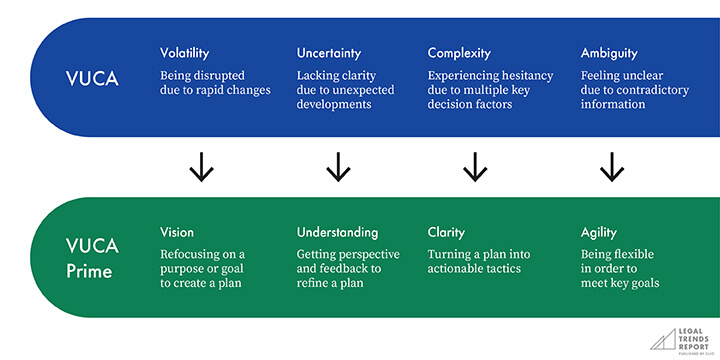
The aggregation of marginal gains
There won’t be any one solution to overcoming the many challenges that 2020 has surfaced. The sheer magnitude of what we’re up against can seem overwhelming, but even the smallest actions begin to add up. This is where the aggregation of marginal gains (a concept discussed in greater detail in Part 2) is critical. The principle of the idea is that the adoption—and continuous application—of many small improvements will, over time, achieve meaningful, long-term change.
The aggregation of marginal gains is a powerful framework that doesn’t just promise results—it opens up many paths to success. Any one action can create positive results down the road, but many actions can dramatically alter the course and speed toward improvement. 2020 will be a pivotal year in steering the future direction of legal, of which technology is becoming a central factor of vision and innovation.
More people have access to the internet than have access to a lawyer.
Professor Richard Susskind, author, speaker, and independent adviser to major professional firms and to national governments, advocates that technology has the potential to not just automate, but utterly transform legal processes. Central to this premise is that “More people have access to the internet than have access to a lawyer,” says Susskind5. In fact, as the internet becomes near ubiquitous within our society, cloud technologies—which today are responsible for virtually all of our online experiences—are what will enable this transformation.
When thinking about the changes that are possible, both large and small, the COVID-19 pandemic has presented us a unique opportunity to rethink, from the ground up, the legal service experience. In reading this year’s Legal Trends Report, I encourage you to imagine what improvements will pay dividends down the road.

[5] Susskind, Richard, “Online justice: The way of the future?” LSJ Online, January 29 2020
What’s new this year
- Understanding the impact and opportunities. The coronavirus pandemic has had a devastating impact on communities and businesses across the world. Clio’s analysis of aggregated and anonymized data from tens of thousands of legal professionals provides unique insight into the depth of this impact, and what strategies have helped firms mitigate these difficulties while also accelerating their recovery.
- Identifying key priorities. We’ve taken an in-depth look at how legal professionals weigh key priorities for themselves and their firms. In utilizing a MaxDiff approach to assessment, we’re able to identify what lawyers believe are their key priorities for success now, and for the future.
- Reimagining client experience in a post-pandemic world. As the rise of cloud-based technologies have helped us cope with everyday social restrictions, they’ve also created the opportunity to redefine client experiences for the benefit of both clients and firms. The data included in this report provides an indication for what this future could look like and the foundation that’s been set in 2020.
Data sources
Each year we use a range of methodologies and data sources to better understand the state of legal practice and what opportunities exist for improvement.
Clio data
The Legal Trends Report uses aggregated and anonymized data from tens of thousands of legal professionals in the United States. This year, we’ve adapted and expanded our analysis to provide more up-to-date data on law firms to better identify the challenges faced during the global pandemic in 2020.
Surveys of legal professionals and consumers
We conducted ongoing surveys of thousands of legal professionals and consumers since the start of the COVID-19 pandemic. The data uncovered in these studies provides unique insight into the challenges and opportunities of 2020.
Longitudinal research
We conducted a longitudinal study following 16 lawyers as they navigated the impact of COVID-19 on their business through April and May. Several snippets of these interviews are featured throughout this report to help describe the experience of working at a law firm in 2020, from lawyers themselves.
2020 Legal Trends Report
Crisis
How times of crisis affect the business of legal practice
- Introduction. Building a vision of a better normal
- Crisis. How times of crisis affect the business of legal practice
- Gains. The aggregation of marginal gains
- Clients. Firm success centers on clients
- Vision. A new vision for cloud-based, client-centered legal practice
- Markets. Addressing underserved legal markets
- Future. The future of law firms will be cloud-based by design
- Appendix A. Hourly rates and KPIs
- Appendix B. Detailed methodology
The initial outbreak of the COVID-19 pandemic has drastically impacted virtually every facet of our world, and the legal profession is no exception. For many law firms, it has had an undeniably negative influence on their business, their clients, and their staff. Dealing with the situation at hand, and building towards a better future, requires a clear understanding of the impact to date.
For five years, the Legal Trends Report has provided benchmark data on key insights to help legal professionals better assess firm performance in relation to the broader industry. The data in this section illustrates how the initial events of the COVID-19 pandemic have impacted firm revenues, creating a shortfall that will affect legal professionals for months—if not years—to come.
Assessing the impact
In the first weeks of March, the World Health Organization (WHO) officially designated COVID-19 as a global pandemic and the United States declared a national emergency. Shortly after, we saw the cancellation of major events, border closings, and steep stock market declines. By the end of March, the impact of the pandemic was in full force, with travel bans and social distancing advisories in place.
We had an immediate panic. We saw an immediate decrease in collections on some specific clients.
These events quickly had a substantial impact on business at law firms. Compared to the previous year, the volume of new casework dropped 6% in March. By April, the number of new matters opened dropped 30% compared to the previous year. Law firms were similarly impacted in May, when new opened matters were down 25% compared to 2019.
In terms of revenue, 2020 was initially trending to become a positive year for law firms, as January and February saw the average firm collecting over 10% more than the year prior. By March, year-over-year revenue began trending lower. In April, the average law firm collected 8% less revenue than the year prior. Even though new matters saw a slight uptick in May, firms saw revenues fall further to 12% below the previous year.
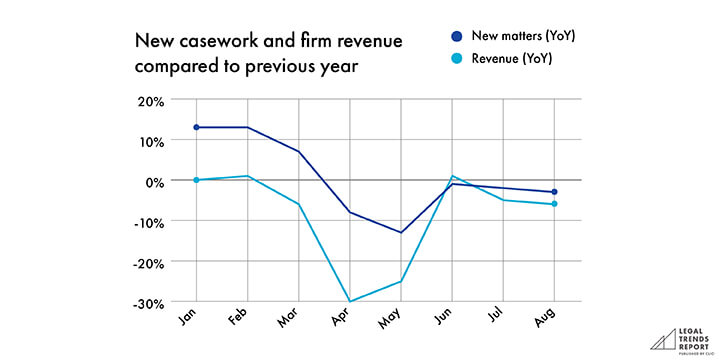
How practice areas and geography were affected
At Clio, we’ve been conducting ongoing research into the impact of the COVID-19 pandemic on law firms since the initial outbreak. This includes a comparison of new matter volume among law firms working in specific states and practice areas, comparing new casework each month to baseline levels prior to the pandemic outbreak in the United States.
Each passing day this week, I feel more gloom and doom that the virus is coming back.
Both the year-over-year analysis in the previous section and the baseline comparison show that the initial months of the pandemic saw a dramatic slowdown of business, but some types of firms were affected more than others. These impacts were especially felt by firms handling criminal, personal injury, and traffic offence matters, as each of these areas saw caseloads fall significantly compared to the months prior to the pandemic. Less-affected practice areas were those related to business matters—such as intellectual property and commercial/sale of goods—which fared much better in the early months and later on. Matters related to real estate also recovered in the summer, and saw new caseloads exceed baseline levels at the start of the year.
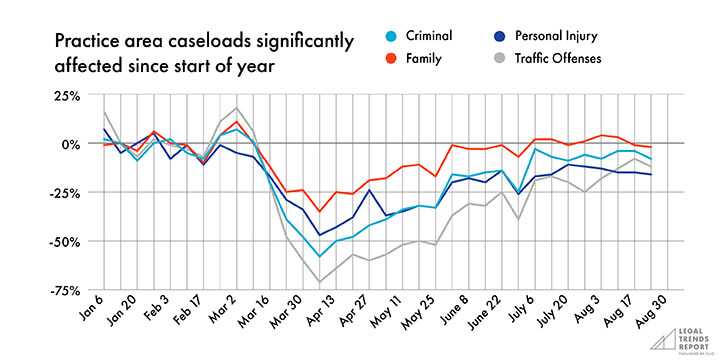
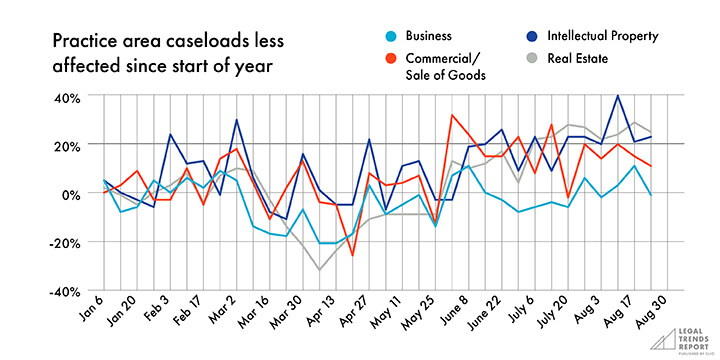
In terms of geography, New York, once the epicenter of the pandemic in the US, faced the most dramatic fall in new casework early in the pandemic. Once coronavirus cases dropped, and remained low, legal work in the state recovered significantly. Other states that saw large surges later on in the pandemic didn’t see as much of a fall in new matter creation, though they saw varying degrees of slowness throughout the summer.
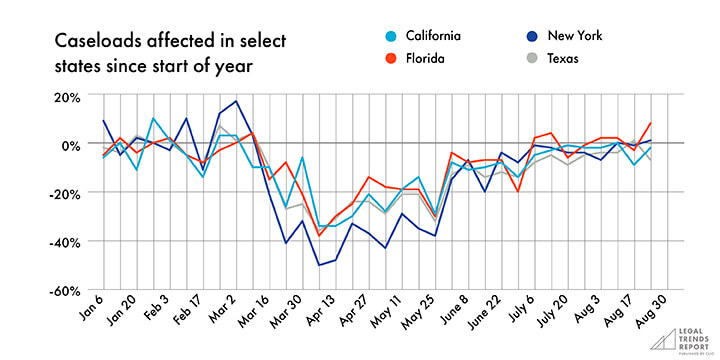
For ongoing analysis on the impacts of the COVID-19 pandemic on law firms, see Clio’s research at clio.com/covid-impact.
The real cost of COVID-19
When looking at the cost of COVID-19 on law firms, we can look at the real dollar-value loss on a per-lawyer basis. While the first months of the year were going well, the sudden drop in new casework resulted in a $1,616 drop per lawyer in April compared to the previous year. In May, this amount fell further to $2,373 per lawyer compared to the previous year.
I’m just trying not to lose too much money…Our estimate is COVID is going to cost us between a hundred and five hundred thousand in revenue just because a lot less cases are coming in.
While the summer months saw significant recovery in new casework, firms continued to see an overall shortfall in monthly revenue, with lawyers bringing in between $473 and $705 less each month compared to the previous year.
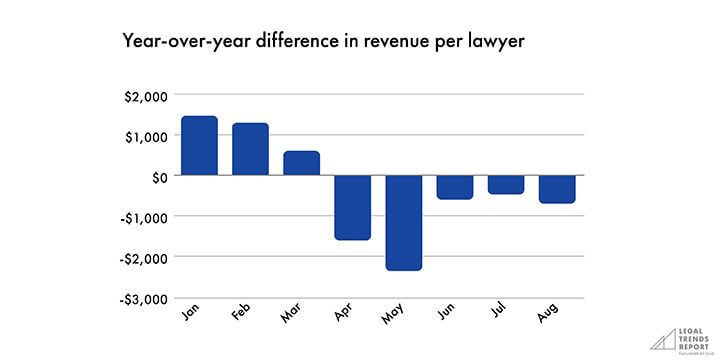
Over time, sustained revenue shortfalls can result in difficult decisions for business owners, many of which we’ve already seen as firm owners have been forced to make cuts. Survey research from April to July shows that between 11% (in April) and 26% (in May) reported having laid off staff during the pandemic, and about the same amount continued to expect future layoffs if these revenue shortfalls persist.
Survey research also shows that anxiety surrounding firm success as well as personal finances remains high in the legal industry, which is likely persisting due to the decreased lawyer earnings. Even as these anxieties have settled during the summer month, still over half of legal professionals are worried about the success of their law firm, and over a third are worried about making a living.
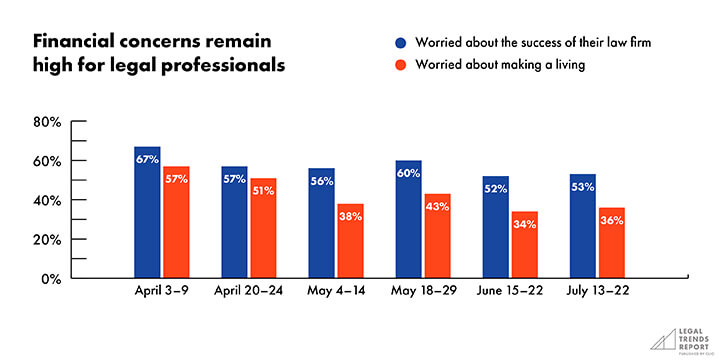
Given the difficulties of the past several months, when it comes to action, law firms should focus on changing this negative-growth trajectory to a positive one. While this may seem easier said than done, the following sections identify and illustrate key areas of opportunities that lawyers can focus on to weather current challenges, as well as build a foundation for success beyond the pandemic.
2020 Legal Trends Report
Gains
The aggregation of marginal gains
- Introduction. Building a vision of a better normal
- Crisis. How times of crisis affect the business of legal practice
- Gains. The aggregation of marginal gains
- Clients. Firm success centers on clients
- Vision. A new vision for cloud-based, client-centered legal practice
- Markets. Addressing underserved legal markets
- Future. The future of law firms will be cloud-based by design
- Appendix A. Hourly rates and KPIs
- Appendix B. Detailed methodology
The outbreak of the COVID-19 pandemic has shown us how times of crisis can have a very sudden and acute impact on businesses. By dealing with the situation at hand, the improvements we make now have the potential to shape future success, and even small changes can lead to larger, more impactful benefits over time.
Building a better normal
During the initial outbreak of the coronavirus pandemic, social distancing restrictions made it difficult for lawyers to find new clients, maintain services for existing clients, and manage the administrative functions necessary to ensure consistent revenue streams.
For many firms, these problems were deeply rooted in physical infrastructure—either paper-based systems or on-premise servers. In fact, the issues with outdated, physical infrastructures have created long-standing issues with regard to staff turnover, sickness and vacation leave, office relocation, and other challenges related to downtime. While these problems may disrupt on a daily basis, more catastrophic circumstances—such as the pandemic, or even fires, floods, or other natural disasters—can fully shut down firm operations for extended periods of time
Everything that I’m doing in the back of my mind I’m thinking how can I make my life easier and how can I make it look more professional?
In this section, we’ll look at data on how certain cloud-based solutions have provided real, quantifiable advantages when it comes to: (1) mitigating negative impacts and accelerating recovery during periods of disruption, and (2) establishing competitive advantages to implement when building a better normal for firm operations.
The aggregation of marginal gains
The aggregation of marginal gains is a concept developed by Dave Brailsford, coach of British Cycling, which was later popularized by James Clear in his book Atomic Gains. The key intention behind the concept is that many small improvements, which may be insignificant in isolation, can compound to create dramatic results—the “aggregation of marginal gains.” This was the case for Brailsford, who continuously focused on small adjustments to improve his team’s performance. No initiative was too small for Brailsford, who redesigned bike saddles for comfort, tested lighter, more aerodynamic uniforms, improved hand-washing to avoid illness, and managed dust contamination of high-performance bikes.
Within five years, Brailsford transformed a chronically deficient cycling team into a championship team that won 60% of the gold medals for cycling at the 2008 Beijing Olympics. The team would go on to win 178 world championships, 66 Olympic or Paralympic gold medals, and five Tour de France races, making them one of the most successful cycling teams in the history of the sport.
We’re going to be a better firm at the end of this. Now it might take two years, three years [to get] through all the impacts, but we’re going to be more focused, more nimble.
Using this framework, this section looks at how small changes can have a significant positive impact on law firm operations. And the concepts in this section illustrate how firms can make improvements to accelerate recovery from the impacts of the coronavirus pandemic in the immediate future. These improvements are also the means to envisioning a new and better normal in the future.
How cloud technology improved adaptability and influences positive growth
For many law firms, the initial onset of the coronavirus pandemic had a significantly negative impact on their business. While these difficulties were likely due in part to the overall slowdown in clients who were willing to pursue their legal problems, we wanted to know whether some firms were able to perform better than others despite these challenges.
We conducted an analysis of aggregated and anonymized data from tens of thousands of legal professionals to compare how the use of three technology solutions within the Clio platform—online payments, client portals, and client intake and CRM software—affected business performance. Each of these technologies are designed to improve the flexibility and adaptability of specific workflows when working remotely with clients, and we believed that these solutions would have a significant positive effect on business performance among law firms using them.
The results of this study show how the adoption of these technologies can create quantifiable gains that have helped law firms reduce the impact of COVID-19, accelerate recovery, and achieve better business performance over time.
Methodology
We compared two groups of law firms: (1) those that started using these technologies by 2019, and (2) those that didn’t use them during the same period. Each of the technologies studied were based on solutions within the Clio platform.
| Technologies studied | Solution in Clio |
|---|---|
| Online payments | Clio Payments |
| Client portal | Clio Connect |
| Client intake and legal CRM | Clio Grow |
Impact on annual growth.
To assess how the use of technology impacted firm performance during the outbreak of COVID-19, we looked at year-over-year growth in new matters and collected revenue. Between these two metrics, we are able to assess both the ability of law firms to generate new business and their ability to capitalize on revenue-generating work.
Month-to-month cohort comparison.
We compared the total volume of new opened matters and collected revenue between those that adopted each technology and those that didn’t since the start of 2019. This comparison shows how using these technologies correlates to overall volume of casework and earned revenue.
Conclusion
Those using the technologies studied in this analysis saw much better year-over-year business performance throughout the pandemic. Firms using these technologies also saw an overall greater volume of casework and revenue on a per-lawyer basis throughout 2019 and 2020.
Additionally, the adoption of more than one technology shows a compounding effect in business performance, both in terms of impact during the coronavirus pandemic and overall volume of casework and revenue collection.
Detailed discussion: benefits to online payments, client portal, and client intake and CRM
Online payments adoption
Online payments enable law firms to collect credit card payments through an online platform like Clio Payments, LawPay, or PayPal. When using these solutions, clients can quickly make payments either in person or remotely through email or an online client portal. The ability to process payments remotely helps maintain business continuity during times when social distancing recommendations are in effect.
Impact on annual growth
During the initial months of the pandemic, when law firms saw a dramatic decrease in new casework, firms that used electronic payments saw negative impacts mitigated by up to 5% compared to the previous year. Firms using electronic payments also saw positive growth in June, and opened up to 6% more matters in the summer than firms not using electronic payments.
When looking at revenue generation, both groups of law firms were affected similarly by the pandemic when comparing year-over-year growth. However, data in the early months of 2020 shows that firms using electronic payments were seeing up to 6% more growth compared to firms not using electronic payments. Through the summer, those using electronic payments collected 2% to 3% more.
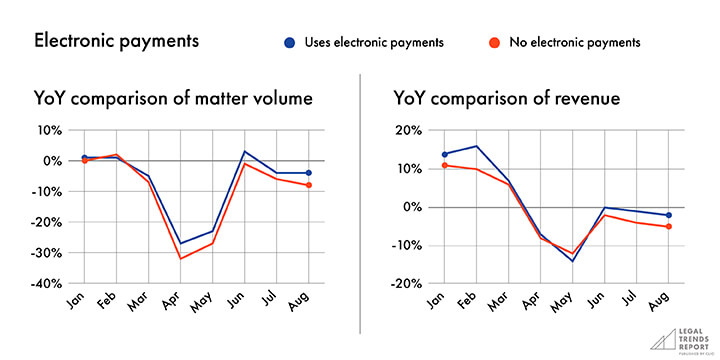
Month-to-month cohort comparison
When comparing firm caseloads on a per-lawyer basis, those using electronic payments saw approximately the same volume of casework in 2019. In 2020, however, firms using electronic payments opened more new matters, an advantage that grew more pronounced during the initial months of the pandemic (up to 7% more matters created in May and 8% in August).
Firms using electronic payments collected $10,429 more per lawyer in 2019, and are projected to collect $15,179 in 2020.
In 2019, lawyers practicing at firms using electronic payments collected 7% more revenue per lawyer. This difference increased in 2020, and spiked to an 11% difference in February and the early summer months. The highest difference was in August, when firms using electronic payments collected 16% more per lawyer.
In total, firms using electronic payments collected $10,429 more revenue per lawyer in 2019, and in 2020 are projected to collect $15,179 more revenue per lawyer.
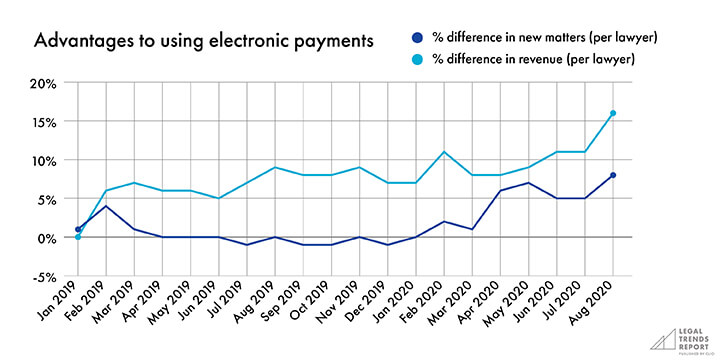
Summary of analysis
The adoption of electronic payments shows clear benefits in terms of an accelerated recovery during the initial months of the pandemic. Firms using electronic payments also have a strong advantage in overall revenue collection on a per-lawyer basis. This means that lawyers working at law firms using electronic payments, on average, bring in more revenue. This advantage increased during the pandemic.
- Electronic payments benefit case volumes. Electronic payments can speed up the process for collecting advanced fee deposits, consultation fees, or any other fees required up-front to begin the legal process. These payments can be requested and paid remotely, which can be a competitive advantage when clients have an urgent legal matter but are practicing social distancing.
- Electronic payments benefit revenue collection. Electronic payment systems make it easier for clients to pay their bill up front. These solutions also provide automated payment plans that can reduce the need for discounting or forfeiting of legal fees.
Client portal adoption
Client portal solutions provide a secure online environment that law firms can use to share information—including documents, bills, and calendar events—with clients. When providing legal services remotely, online portals help ensure that clients can securely access up-to-date information on their matters at any time.
Impact on annual growth
Firms using client portals mitigated the negative impact on caseloads by 5% during the initial onset of the pandemic in April. In the following months, firms using client portals continued to perform better than firms not using client portals by at least 2% and saw positive growth in June.
When comparing year-over-year growth in revenue, firms using client portals saw consistently higher performance compared to those not using them. This advantage in revenue collection was consistent both during the months leading up to and during the coronavirus outbreak. Firms using client portals achieved a net-zero impact by June 2020 and consistently maintained at least 2% (and up to 5%) more growth in 2020 than firms not using client portals.
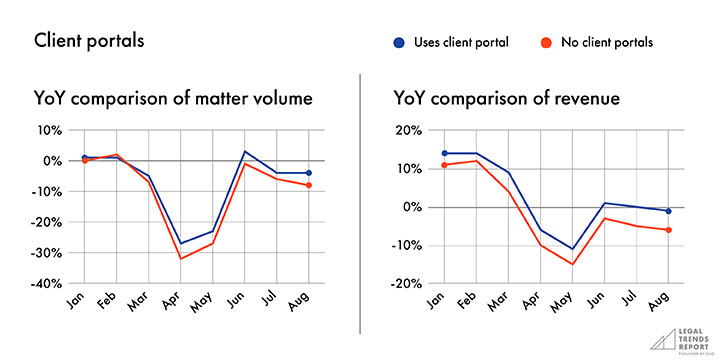
Month-to-month cohort comparison
When comparing caseloads on a per-lawyer basis, firms using online client portals saw up to 11% more casework than other firms in 2019 (average of 9% difference for the year). In 2020, firms using online client portals saw 17% more new casework per lawyer in April, and 12% or more through the summer.
Firms using client portals collected $16,556 more per lawyer in 2019, and are projected to collect $23,587 more in 2020.
In 2019, lawyers practicing at firms using client portals collected an average of 11% more revenue per lawyer. This difference increased in 2020, achieving a 15% advantage or more after March and up to 21% in August.
In total, firms using client portals collected $16,556 more revenue per lawyer in 2019, and in 2020 are projected to collect $23,587 more revenue per lawyer.
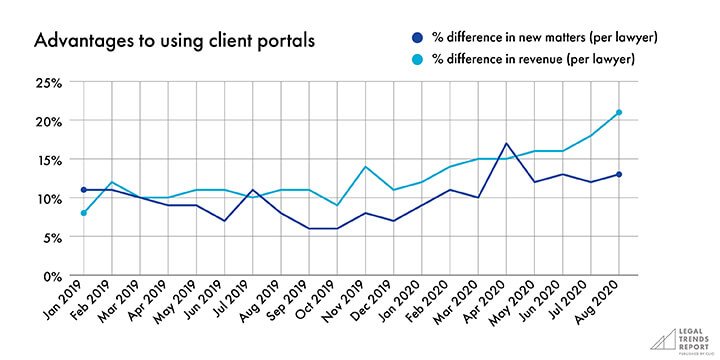
Summary of analysis
Data analyzed in this section indicates that firms using client portals were better able to mitigate the negative impact on overall casework during the initial outbreak of COVID-19. Firms using client portals typically see an overall higher volume of matters and collected revenue, which is a trend that increased during the coronavirus pandemic.
- Client portals support the transition from in-person to remote client services. Firms using client portals ensure that matter information is stored securely in an online environment that is accessible to both lawyers and clients, regardless of their location.
- Client portals improve revenue collection. Client portals support more efficient firm operations by reducing the amount of one-on-one interactions with clients (who can instead access information through a portal). Firms using client portals may be able to spend more time on billable work and to create the types of positive client experiences that result in more positive reviews and referrals.
Client intake and CRM adoption
Client intake and CRM solutions refer to software that helps manage the communications and intake that take place prior to a contact becoming a client. Firms using client intake and CRM solutions create efficient online intake workflows for new clients, which often include web forms, the ability to pay up-front fees through online payments, and the ability to quickly book initial consultations online.
Impact on annual growth
Firms using online client intake and CRM solutions saw better year-over-year performance compared to those not using these technologies, both leading up to and during the initial months of the coronavirus outbreak. These firms saw as much as a 6% year-over-year difference in April, 7% in July, and 9% in August compared to firms not using client intake and CRM solutions. These firms also achieved positive growth in matters from June onward.
In terms of revenue, firms using client intake and CRM solutions saw nearly double the growth in the first months of 2020 than other firms, and maintained better annualized performance during the initial months of the pandemic. These firms achieved positive growth from June onward, and saw as much as 10% more growth.
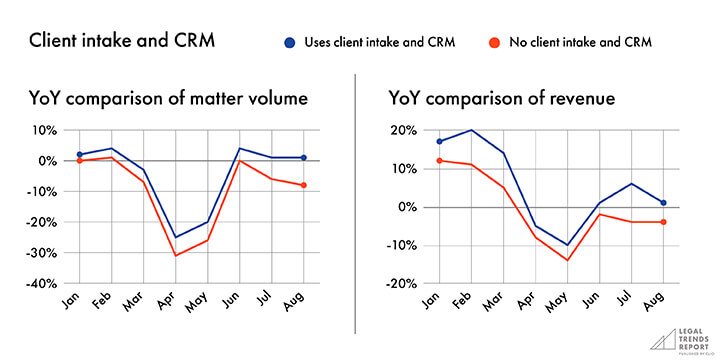
Month-to-month cohort comparison
When comparing caseloads on a per-lawyer basis, firms using client intake and CRM solutions saw 16% more casework in 2019. In 2020, firms using client intake and CRM saw over 20% more cases every month from February onward.
Firms using client intake and CRM software collected $15,124 more per lawyer in 2019, and are projected to collect $27,304 more in 2020.
In 2019, firms using online client intake and CRM systems saw 9% more revenue, per lawyer. This difference increased overall in 2020, reaching a high of 26% more revenue in August.
In total, firms using client intake and CRM collected $15,124 more revenue per lawyer in 2019, and in 2020 are projected to collect $27,304 more revenue per lawyer.
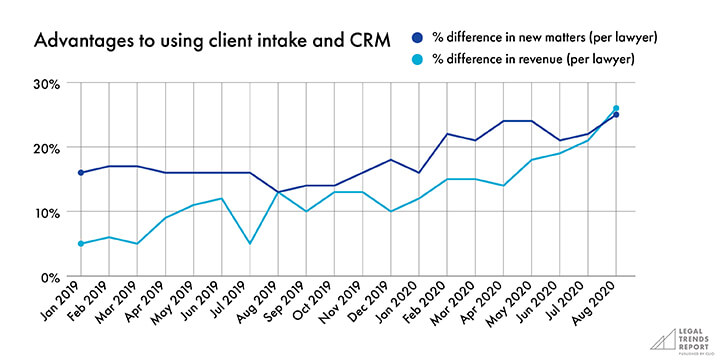
Summary of analysis
Firms using client intake and CRM solutions started off as higher performers and showed more resilience during the pandemic, achieving better year-over-year performance in terms of both case volumes and revenue collections. These advantages are seen during the months leading up to and throughout the pandemic. These firms have also seen substantially higher caseloads and revenue collection through 2019 and 2020.
- Client intake and CRM helps generate new casework. In competitive markets, these solutions enable quicker engagement with potential clients, allowing them to book appointments directly into the firm’s calendar. This provides an advantage over firms that take longer to arrange appointments and may be slow to respond to client inquiries through other means.
- Client intake and CRM improves new client engagement. These solutions enable new clients to provide matter information quickly and efficiently through online intake forms, which also support remote workflows during social distancing recommendations. This can accelerate the engagement process and creates more commitment to pursuing a legal problem.
- Client intake and CRM reduces the number of lost client opportunities. These solutions create a system for streamlined contact management and communications with potential clients, helping ensure follow-ups that keep legal issues top of mind.
Adoption of multiple solutions
Each of the technology solutions included in this analysis—online payments, client portal, and client intake and CRM solutions—have shown quantifiable benefits in terms of casework and collected revenue. These benefits apply to the time periods prior to the coronavirus pandemic and throughout.
When looking to implement changes that will achieve the types of aggregated marginal gains discussed earlier in this section, each of these solutions represents a specific and actionable initiative that firms can implement to accrue substantial benefits over time. When used in conjunction, however, this analysis demonstrates how implementing more than one of these technologies creates a compounding effect to achieve even greater results over the same period of time.
Impact on annual growth
Law firms that use all three of these technologies saw a dramatically lessened impact on casework during the initial months of the pandemic—an overall difference of 10% for April and May compared to firms not using these solutions. By June, these firms achieved positive year-over-year growth in casework, which they maintained through the summer. During this period, those not using these technologies were still in decline.
In terms of revenue, firms using these technologies saw as much as 10% more revenue growth compared to other firms prior to the pandemic. During the initial outbreak, these firms only saw two months of negative growth, falling to a low of -7%. From June onward, these firms achieved positive growth in revenue as high as 6% in July. Firms not using these technologies have continued to see negative revenue growth, as low as -14%, since April, and have yet to see their income streams recover.
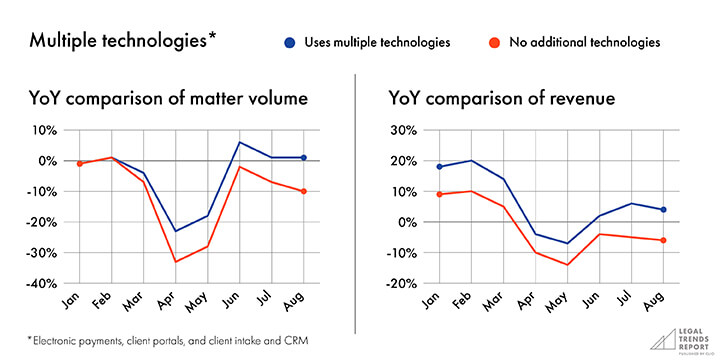
Month-to-month cohort comparison
Firms using all three technologies averaged a much higher volume of casework per lawyer in 2019, up to 21% (average of 16% for the year). This difference increased to as much as 34% per lawyer in April during the initial outbreak of the pandemic—and remained at or above 27% for the following months.
Firms using multiple legal technology solutions collected $19,541 more per lawyer in 2019, and are projected to collect $37,622 more in 2020.
In terms of revenue, firms using these technologies earned as much as 19% more revenue per lawyer than those not using them in 2019 (an average of 13% for the year). As of 2020, these firms consistently earned over 20% more revenue, and as much as 39% more in August.
In total, firms using online payments, client portals, client intake and CRM solutions collected $19,541 more revenue per lawyer in 2019, and in 2020 are projected to collect $37,622 more revenue per lawyer.
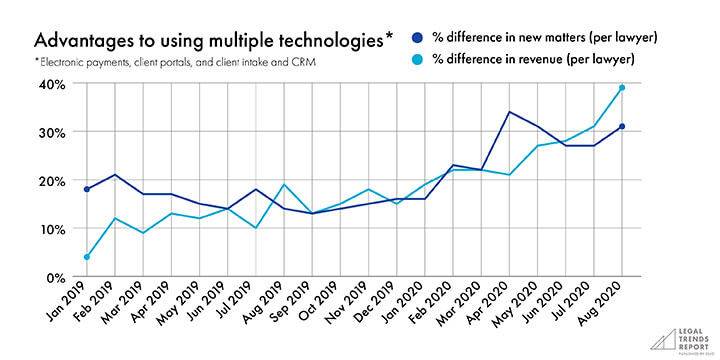
Summary of analysis
When comparing the impact of the technology tools analyzed in this section, each provides measurable benefits to law firm performance while delivering better remote and in-person client experiences. While the pandemic has been difficult for most firms, these benefits ensured that firms were better able to serve clients and maintain business continuity during the initial months of the outbreak. Overall, these technologies also resulted in firms bringing in more casework and earning more revenue per lawyer in 2019 and 2020.
How the aggregation of marginal gains affects revenue collection over time
We’ve seen in the analysis above that the adoption of cloud-based and client-centered technologies can have real impacts on firm performance, and can even greatly reduce the negative impact of COVID-19 on law firms. In fact, firms that have adopted these technologies are seeing positive growth, while those that haven’t are still seeing shortfalls.
Firms that adopt these technologies not only elevate their quality of client services, they also realize even greater gains, which pay off more over time.
When we look at the overall comparative benefit to firms, the conclusions couldn’t be more clear. The adoption of any one of the solutions looked at in this section can create comparatively real benefits. Firms that adopt these technologies not only elevate their quality of client services, they also realize even greater gains, which pay off more over time.
In looking to the future, this type of analysis shows how adaptability—or the Agility component of VUCA Prime—should be a priority for law firms looking to improve their businesses, either now or in the future. While this section has focused on three specific technology solutions as examples, the following sections in this report look at other areas that may provide law firms opportunities to innovate and improve. Firms that prioritize new innovation in client services—and are quick to adopt them—are the ones that will see greater rewards.
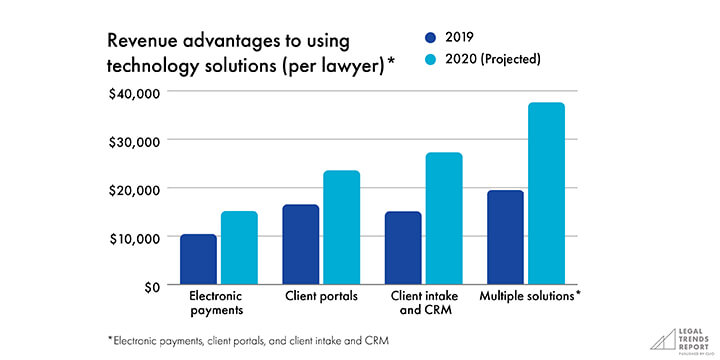
2020 Legal Trends Report
Clients
Firm success centers on clients
- Introduction. Building a vision of a better normal
- Crisis. How times of crisis affect the business of legal practice
- Gains. The aggregation of marginal gains
- Clients. Firm success centers on clients
- Vision. A new vision for cloud-based, client-centered legal practice
- Markets. Addressing underserved legal markets
- Future. The future of law firms will be cloud-based by design
- Appendix A. Hourly rates and KPIs
- Appendix B. Detailed methodology
We’ve looked at how firms have been affected in 2020, and we’ve seen evidence of how small changes, when compounded, can lead to big impacts when it comes to firm success. But what should lawyers focus on when planning for the future success of their firms?
When we talk about 2020 being the epitome of a VUCA environment, one of the most challenging aspects of this situation is the lack of perspective. The ambiguity of not knowing what to do can impede decision-making when action is most important.
To build the type of perspective that enables action, the Vision and Clarity components of VUCA Prime are designed to neutralize the volatile and complex nature of the VUCA environment. One way to gain this vision and clarity is to identify exactly what’s most important to the moment at hand.
Assessing priorities: The MaxDiff approach
2020 has given us a key moment to zero in on what really matters to lawyers and their clients, while also illuminating the most immediate and pressing challenges that firms face. These challenges are also where firms will find their greatest opportunities for innovation and improvement.
To better understand how law firms should think about the future, we conducted a method of study known as a MaxDiff analysis, which allows us to identify what priorities are most important for lawyers and their clients.
What is a MaxDiff analysis? Survey respondents review several lists of randomized items and identify the most and least important. The method requires respondents to make a series of trade-off decisions so that we can determine the degree of importance relative to all other factors.
In reviewing the data from over 2,000 respondents that include legal professionals and consumers, we can calculate the percentage of times each item was chosen as the most and least important among the list of items. We then subtract the percentage of times that an item was selected as the least important from the percentage of times it was selected as the most important. The result gives us a MaxDiff score, which indicates the overall consensus among respondents as to which items are the most and least important overall.
Clients are the priority as law firms focus on survival
The first MaxDiff analysis we conducted was designed to understand how legal professionals define success for their law firm. The results show that when asking lawyers to identify what’s most important to defining their firm’s success, the happiness and satisfaction of their clients ranked at the top of the list. In other words, when compared to the other factors, it’s clear that lawyers care deeply about their clients and their outcomes, more so than their own job security and personal health.
To you and me it’s a case. To them it’s their life.
In conducting this analysis, we can also see which topics are the most contentious among respondents. For example, about an equal number of respondents were divided on whether exceeding last year’s revenue was the most or least important to them. This suggests that growing revenue and profitability is still the top priority for many lawyers, but for others it’s the furthest from their mind. Overall, increasing revenues nets out with a score of only 3% compared to other factors on the list.
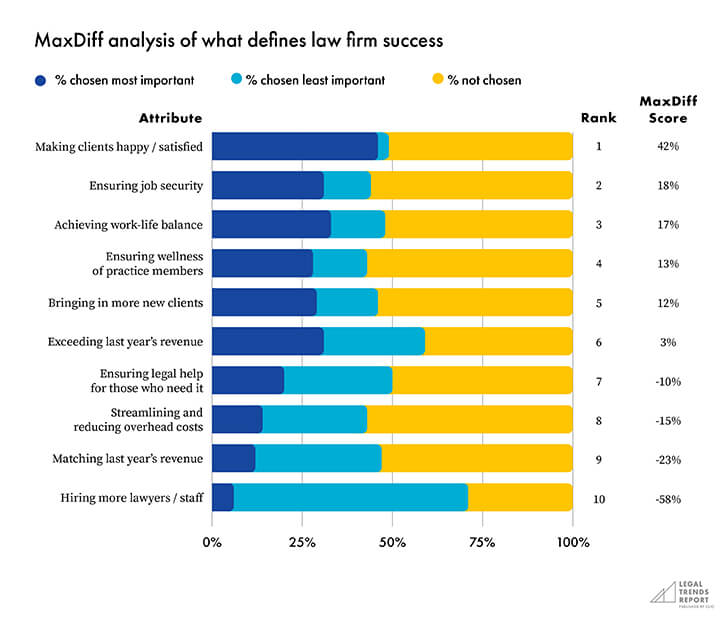
The MaxDiff analysis also gives us an indication of just how much more important each item is compared to others. While client satisfaction is the highest scoring priority for law firms, job security and overall health and wellness are also key concerns to balance for many lawyers.
Growth-related goals, on the other hand, have since fallen to the wayside. Hiring more lawyers and staff was ranked as the least important over other factors in the list. Overall, bringing in new clients and increasing revenue ranked comparatively lower than the other, more stability-oriented goals on the list. For comparison, in 2018, increasing firm revenue was the most common goal for lawyers surveyed6. In 2019, 87% of lawyers wanted to see their firms grow—and revenue and client base were the top two areas that they wanted to see grow7.
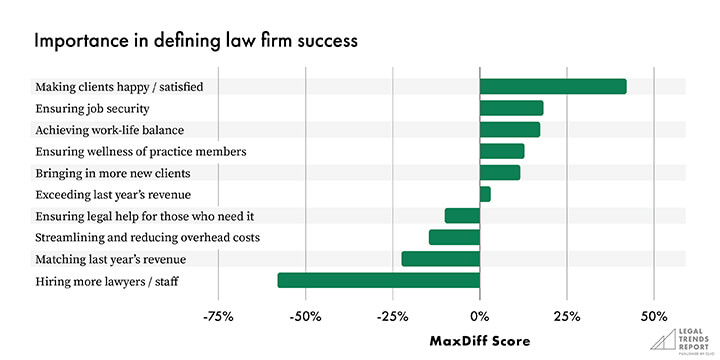
[6] Clio, Legal Trends Report, 2018
[7] Clio, Legal Trends Report, 2019
Client satisfaction also drives firm success
We also conducted MaxDiff analyses to determine what lawyers saw as the most important priorities to achieving success for their law firms, which we compared to what consumers indicated was the most important to determining a lawyer’s hireability.
The data from this analysis indicates that at least part of why legal professionals define their firm’s success based on the satisfaction of their clients is because they also view positive referrals and reviews as key drivers of new business. Client satisfaction is the highest ranking factor to achieving success among legal professionals, which is also consistent with what clients are looking for. Among consumers, positive reviews or personal recommendations are the most important factors when considering the hireability of a lawyer.
It just makes you reevaluate. What’s valuable to me? What can I do to protect myself? What can I do to help others?
The results across each MaxDiff analysis indicate that, when it comes to firm success, everything stems from the success of its clients. In fact, client-centered design is a well-established business strategy based on the idea that ensuring client success is what gives businesses the inertia to continuously thrive.
In reviewing the other factors that ranked highly among lawyers and consumers, we can identify how to set priorities along both of these dimensions for client-centered innovation. In terms of a VUCA Prime mindset, these priorities help bring vision and clarity for action.
When looking at the other key factors in the MaxDiff analysis, we see three critical areas of opportunity for innovation in the coming months and for building a better normal for the future.
- Law firms see value in technology. Legal professionals rank technology as a high priority to their firm’s success. In Part 2, we saw how technology adoption can influence dramatic results in improving resilience during times of crises, while also elevating success during more profitable times. Part 4 will look at how the adoption of cloud-based technologies have enabled a new degree of flexible and more efficient client services.
- Clients care about affordability. Consumers rank affordability factors—which include pricing and discounts, payment plans, and fixed fee billing—as the most important (aside from positive reviews) when it comes to lawyer hireability. Part 5 looks at how the issue of affordability can be observed across multiple dimensions, and how developing more client-centered service models in legal has the potential to reduce barriers for clients seeking legal representation.
- Brick-and-mortar law offices don’t factor into success. Access to commercial office space ranked dead last on the priority list for both legal professionals and consumers, which brings into question the in-person nature in which legal service has traditionally been practiced. Part 6 looks at the current trends in the delivery of remote legal services, and what opportunities lie ahead for the future of legal.
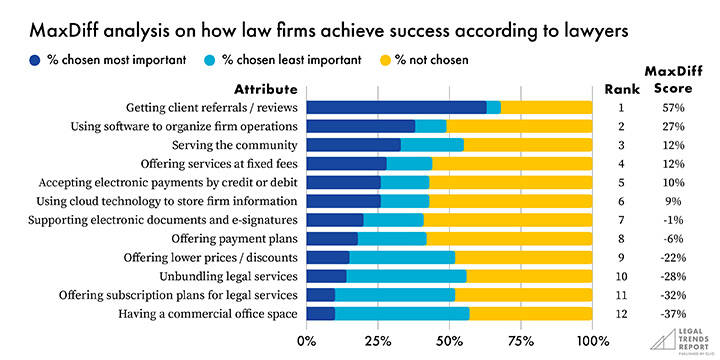
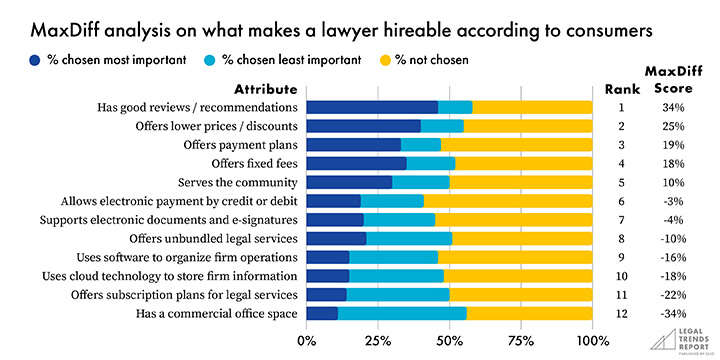
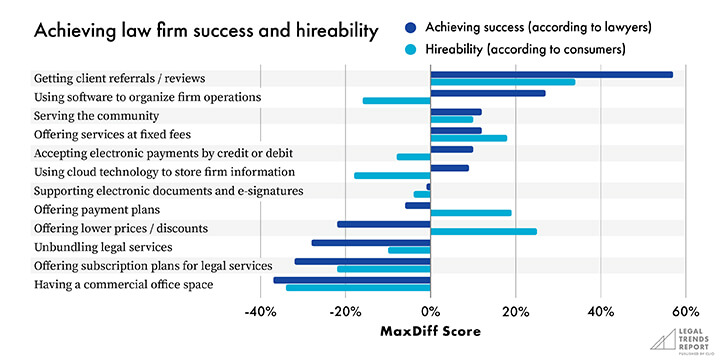
2020 Legal Trends Report
Vision
A new vision for cloud-based, client-centered legal practice
- Introduction. Building a vision of a better normal
- Crisis. How times of crisis affect the business of legal practice
- Gains. The aggregation of marginal gains
- Clients. Firm success centers on clients
- Vision. A new vision for cloud-based, client-centered legal practice
- Markets. Addressing underserved legal markets
- Future. The future of law firms will be cloud-based by design
- Appendix A. Hourly rates and KPIs
- Appendix B. Detailed methodology
In 2020, we’ve seen an increased reliance on cloud-based technology beyond anything we’ve seen since the dawn of the internet. In the first weeks of the pandemic, consumption of online media skyrocketed, and people turned to social networks and videoconferencing technology to stay connected. Social distancing did not have to mean social isolation.
We need to not treat this like a patchwork of temporary solutions. Let’s market it for what it is, which is the reality.
This degree of cloud-based technology adoption has become integral to our new normal, and it’s given many the ability to work remotely—often in more efficient ways that were never possible before. While these circumstances are not without challenges, it’s also difficult to imagine turning back on so many of the benefits that have been achieved in 2020.
While we arrived at the new normal largely out of necessity, looking forward, it will be important to envision what a better normal can be—one that is more purpose-built to what we want to achieve.
Client-centered innovation has gone online
As discussed in Part 3, it’s clear that client satisfaction should be a top priority for law firms in designing the future of legal services. Knowing what clients are looking for helps attract and retain clients more efficiently and with fewer lost opportunities. Delivering on what clients need throughout the course of their matter, in a way that is effortless and convenient for them, earns higher client satisfaction—which in turn drives new business through positive reviews, repeat business, and referrals.
In looking at the trend among consumers, it’s clear that 2020 has accelerated technology adoption to the point where online interactions have become a baseline requirement for any business. We’ve already seen rapid adoption of internet-based technologies in the 21st century: In the United States, 90% of adults use the internet8, 81% own a smartphone9, and the use of smart home devices is growing at a rate of 31% per year10. Now, cloud-based services are permeating mass consumption.
You’d be surprised how many people really get it. I had a 90-year old sign an engagement agreement on an iPad the other day.
In August, 50% of consumers said they were more comfortable with technology, 52% said they were using technology more, and 58% said it was more important to them than before the pandemic.
What this will mean is that businesses will not design their client services based on physical interaction as the default—and online through remote technologies an afterthought. Instead, businesses will need to design client experiences that are online-first. Being online-first may not mean shifting entirely to digital. Instead, many interactions could take on a hybrid format, where clients rely on in-person interactions at certain milestones within their case and opt for online interactions at other times. Designing services in a way that allows lawyers and clients to seamlessly shift to physical or remote interactions as needed will ensure a high degree of flexibility and ease for both parties.
- 58% of consumers said that technology is more important to them now than before the coronavirus pandemic.
- 50% of consumers say they’re more comfortable with technology now than before the coronavirus pandemic.
- 52% of consumers say they use more types of technology tools now than before the coronavirus pandemic.
[8] Pew Research Center, Internet/Broadband Fact Sheet, June 12, 2019
[9] Pew Research Center, Mobile Fact Fact Sheet, June 12, 2019
[10] McKinsey & Company, There’s No Place Like [A Connected] Home, 2016
How will technology shape client experiences?
When it comes to designing a firm’s services to meet the needs of online client interactions, survey data shows three critical areas that law firms need to focus on in meeting expectations.
- Videoconferencing. Many consumers (37%) prefer to meet virtually with a lawyer for a consultation or first meeting, and 50% would rather conduct follow-up meetings through video conference. 56% of consumers would prefer videoconferencing over a phone call.
- Electronic payments. The majority of consumers (65%) prefer to pay using electronic forms of payment, such as credit cards, debit cards, or online payment systems such as Clio Payments, PayPal, or Apple Pay over cash or check.
- Electronic document management. The majority of consumers (69%) prefer working with a lawyer who can share documents electronically through a web page, app, or online portal. Many electronic document systems now offer seamless e-signature services as well.
- 69% of consumers prefer to share documents electronically.
- 37% of consumers prefer videoconference when meeting their lawyer for the first time.
- 56% of consumers prefer videoconferencing over a phone call.
- 65% prefer to pay through electronic payments.
- 50% of consumers prefer to videoconference throughout their matter.
The perception of legal in 2020
The legal profession has not been known for rapid technology adoption. In fact, lawyers are often perceived as operating their business through relatively archaic means. This is illustrated by survey data on consumer perceptions of tech adoption among law firms:
- Only 29% of consumers think most lawyers can access firm information online.
- Only 29% of consumers believe most lawyers are able to securely share documents and allow e-signatures online.
- Only 26% of consumers think most lawyers are meeting with clients virtually.
- Only 40% of consumers believe most lawyers accept electronic payment through credit or debit.
- Only 42% of consumers think most lawyers use computer software at their firms.
In the eyes of consumers, lawyers have a long way to go in developing the types of services that clients are looking for. The reality is, however, that technology adoption among lawyers has been substantial in 2020—to the point where many in the industry have built a foundation to greatly improve legal services that are more in line with client expectations.
Lawyers have embraced technology in 2020
In the MaxDiff analysis discussed in Part 3, aside from client referrals and reviews, technology adoption was the highest ranked priority for driving firm success. What has this mindset meant for law firms in 2020? Legal professionals have shown a level of technology adoption never before seen in the industry.
During the initial impact of the pandemic, 83% of legal professionals viewed cloud technology as necessary to the survival of their law firms, and in May 82% said that technology had become more relevant.
I think this pandemic is pushing people to be more technologically savvy. It’s going to hurt people that are resistant…Those who are able to adapt and make these changes, I think they’re going to thrive.
Now, the vast majority (85%) of law firms are using software to manage their practice, and 79% of lawyers rely on cloud technology to store their firm’s data. Additionally, 62% of firms allow clients to securely share and sign documents electronically, 73% allow clients to pay invoices electronically, and 83% of firms are meeting with clients virtually. As we’ve seen in Part 2 of this report, these types of technology can have real, quantifiable benefits for law firms—both during normal times as well as in times of difficulty when being able to access firm information online is a necessity.
These trends indicate that legal professionals have better access to firm information, and are more prepared to work with clients online to offer greater flexibility and efficiency in delivering legal services.
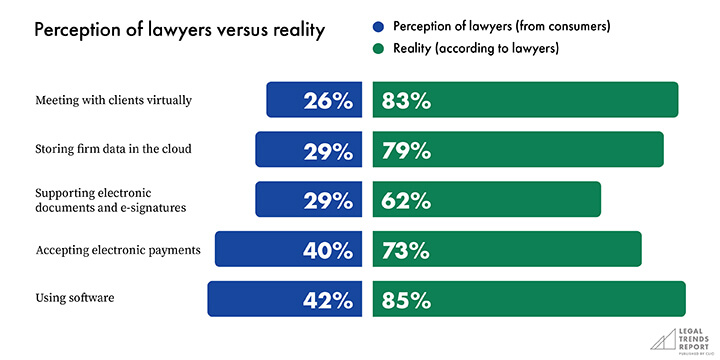
Beyond 2020, the future will remain cloud-based and client-centered
The shift to cloud-based services is more than a coping mechanism for 2020. The need to work remotely has encouraged the online transition that many law firms had been putting off, and it’s a direction they won’t be able to turn back from. Legal professionals are more resilient, have better work-life balance, and provide better services to clients:
- 68% of legal professionals are more prepared to handle the impact of future waves of coronavirus.
- 58% of legal professionals say technology has improved their work-life balance during the pandemic.
- 68% of legal professionals say technology has helped their firms deliver better client experiences during the pandemic.
Even with the level of technology adoption we’ve seen in 2020, the trend points to an even greater focus on online solutions: The vast majority of legal professionals say they will continue using these technologies beyond the pandemic, and 84% of legal professionals say they could serve their clients even better if more parts of their practice were automated with technology.
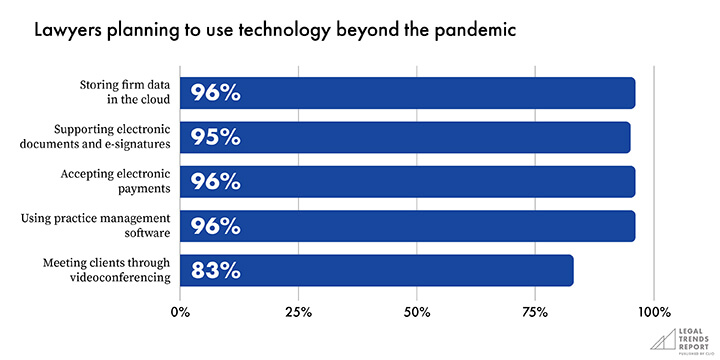
Technology adoption beyond law firms
Beyond the context of law firm operations, court systems stand to benefit from increased technology adoption as well. As many courts have also adapted to incorporate new processes and many types of cases have proceeded in virtual formats, new opportunities have emerged in turn. Specifically, there is now the opportunity to reconfigure how these systems operate in delivering dispute resolution services that are more efficient, more affordable, and more comprehensible to the people they are meant to serve—and ultimately help improve access to justice.
It’s a bold vision, but many legal professionals already see the opportunity:
- 89% of legal professionals believe court systems can be improved with better access to technology.
- 95% of legal professionals believe that courts should use electronic case management systems to organize and file case-related documents.
- 94% of legal professionals think judges should be allowed to sign court documents electronically.
- 88% of legal professionals believe that the public should be allowed to access court files electronically through an online portal.
We’ve also seen that technology adoption can be divisive when it comes to issues of access and fair outcomes:
- 49% of legal professionals believe that technology is a powerful equalizer when it comes to justice issues.
- 45% of legal professionals believe technology can help create a more equitable justice system.
In speaking with legal professionals as part of our longitudinal study, many identified the barriers that technology can create, especially to those without the hardware or the means to access the internet. This can especially be an issue for some of the most vulnerable populations in the US.
I don’t know how these people who are less privileged will be able to access legal services unless there’s a computer bank at a courthouse.
In building a vision for the future, and one that’s increasingly shifting to an online-first structure for legal services and perhaps the broader justice system as well, embracing an approach that allows multiple forms of interaction will help create a more versatile and robust system that’s better suited to the needs of everyone.
2020 Legal Trends Report
Markets
Addressing underserved legal markets
- Introduction. Building a vision of a better normal
- Crisis. How times of crisis affect the business of legal practice
- Gains. The aggregation of marginal gains
- Clients. Firm success centers on clients
- Vision. A new vision for cloud-based, client-centered legal practice
- Markets. Addressing underserved legal markets
- Future. The future of law firms will be cloud-based by design
- Appendix A. Hourly rates and KPIs
- Appendix B. Detailed methodology
While the affordability issue has been a longtime concern in the legal industry, the events of 2020 have only intensified the challenge. Any current or future-facing business strategy needs to take this into account. And with the view of building a better normal beyond the pandemic, innovating new cost and payment structures that enable more consumers to pursue their legal problems will unlock massive market potential for firms that are able to implement them.
The latent market for legal services is expanding
The affordability of legal services has been a well-researched and documented issue for people living in the US, and it is likely a significant barrier to the 77% of people who don’t pursue their legal problems11. Recent research indicates that 86% of civil legal problems faced by low-income individuals receive either inadequate or no legal help at all12.
Prior to the pandemic, according to research conducted by the Federal Reserve on the economic well-being in US households, in 2018 39% of Americans didn’t have funds available to pay for a $400 emergency expense. In 2013, this number was even higher at 50%13. Given that the average rate for a lawyer in the US is $290 per hour14, the research from the Federal Reserve indicates that the average American couldn’t afford to deal with a legal issue that would require more than 1.4 hours of a lawyers’ time.
In 2020, with unemployment rates and job insecurity reaching record levels, the affordability of legal services is an issue that’s only grown increasingly problematic for consumers. In July, 61% of consumers said they would not be able to afford to deal with a legal problem.
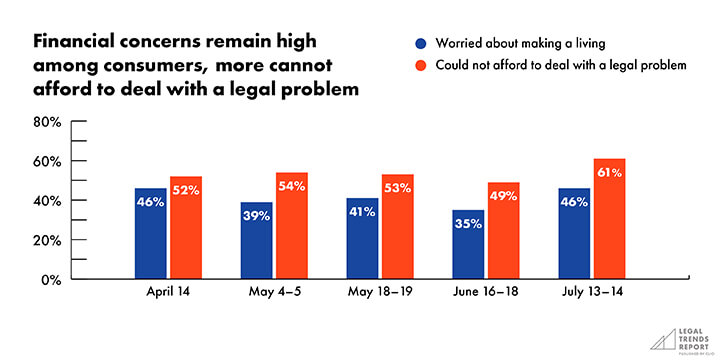
Efforts within the legal industry like pro bono services and legal aid programs aim to bridge the gap between legal services and those who can’t afford them, but it’s clear that the gap is too wide to be solved through pro bono services alone. In the words of Justice Deno Himonas, who has helped lead a market-based approach to the provision of legal service in Utah: “We cannot volunteer ourselves across the access-to-justice gap.”15
The fact that so many legal problems aren’t pursued indicates that there are larger, more structural issues within the profession itself. These issues are characterized by the fact that legal services have been delivered in a way that’s been unaffordable, inconvenient, and difficult for potential clients to know whether they have a legal problem worth pursuing in the first place—all of which function as critical barriers to hiring a lawyer.
We cannot volunteer ourselves across the access-to-justice gap.
Put together, these challenges indicate a critical product-market-fit problem within the legal industry. That is, the average lawyer delivers legal services in a way that is fundamentally outdated when compared to the needs of today’s clients.
[11] World Justice Project, Global Insights on Access to Justice, 2018
[12] Legal Services Corporation, Justice Gap Report, 2017
[13] The Federal Reserve, Report on the Economic Well-Being of U.S. Households in 2018 – May 2019, Last Update: May 28, 2019
[14] See Appendix
[15] Ambrogi, Bob, “Breaking: In Historic Vote, Utah Supreme Court Approves Sweeping Changes in Legal Services Regulation,” LawSites, August 13, 2020
There is more than one dimension to affordability
78% of consumers say that lawyers should adopt pricing and/or payment models that will make legal services more affordable, but “affordable” is about more than just an overall price. In fact, price is only one facet to fitting the needs of the broader market. While many law firms take a very narrow view on affordability—turning to discounts as the only method for accommodating clients—there is a much broader range of solutions available.
Survey data shows that 40% of law firms regularly reduce prices or offer discounts to clients. While reducing prices and offering discounts may be a short-term solution to a client’s inability to pay the bill, and may even improve their satisfaction, there are a number of drawbacks for the law firm:
- Expectations for future reductions and discounting. As law firms rely on referrals for future business, regular discounting can become a requisite for positive reviews—and future clients may come to expect the same price reductions.
- Revenue unpredictability. Firms that regularly discount their services will have a more difficult time predicting future revenue based on their current caseloads, as the final bill remains uncertain until actually paid.
- Devaluing legal services. Rampant discounting can have a significant negative impact on firm revenues, hindering profitability and future growth.
- Lost client opportunities. Given that clients consider price when hiring a lawyer, providing a high price up front—only to discount later—risks turning the client away to a lawyer with more competitive pricing.
I feel like sometimes when you have an attorney, you don’t budget for it. So people don’t think it’s a priority, but it’s just like getting your nails done. You’ve got to pay for the service that you’ve been provided.
While there may be very good reasons for firms to discount their pricing for clients, lawyers should look at expanding their notion of affordability by exploring other tools and structures for packaging their legal services. To start with, payment plans and fixed fee billing are two factors that ranked highly among consumers in our MaxDiff analysis, and both may help make legal services more affordable for clients.
Payment plans provide flexibility
Beyond the total cost of an invoice, requiring full payment within 30 days can make legal services cost-prohibitive for many. While clients are likely to ask for discounts before or after receiving a bill, increasing the timeframe for payment can also increase affordability.
Payment plans are often overlooked by small businesses, but the reality is that they give consumers the means to purchase goods and services that they would otherwise be unable to afford. By setting up payment plans for clients, businesses allow their clients to pay the amount owed over an extended period of time through a series of installments, often with a small amount of interest.
Survey data in May shows that the majority of consumers (72%) would prefer to pay their legal fees on a payment plan, yet just over half of law firms (53%) offer them.
Given that affordability, and payment plans specifically, rank highly in importance among consumers, law firms should make them more available—and more visible—to clients. If the majority of potential clients looking to hire a lawyer are concerned about cost, being up-front about payment flexibility will encourage clients to explore their options.
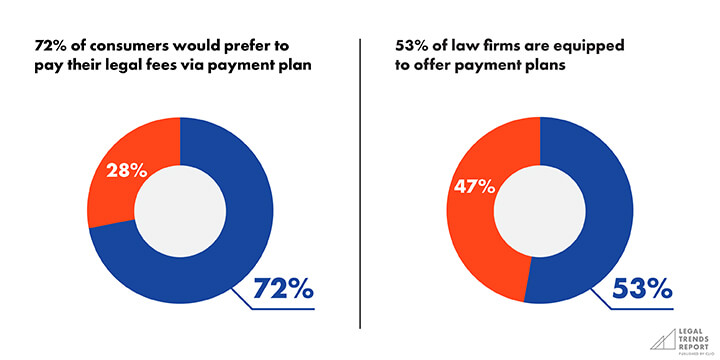
Transparent pricing creates predictability for consumers (and lawyers)
Fixed fee billing structures ranked highly in importance among consumers in the MaxDiff analysis of what makes a lawyer hireable. Flat fees, typically associated with a more productized format for professional services, make pricing simpler, more transparent, and more predictable for clients, which in turn makes it easier for clients to plan for and pay for legal services.
Cost predictability helps consumers determine whether they have the funds available to pursue their legal issue. Knowing how much it will cost and when payments will be due helps them prepare the required funds, and it may also give them the information necessary to make a cost-benefit evaluation on whether pursuing the matter will provide the value they are looking for. This transparency gives them more confidence in their decision to move forward with a legal matter, and reduces the need to dispute or request discounts on bills in which they had no prior insight.
The vast majority of our clients now, even more than normal, are not wanting to take the risk on an hourly retainer. They’re choosing a flat fee instead…They’re craving the certainty of knowing, “This is the most I’m going to have to pay, that won’t get any worse than that.”
According to survey data, 63% of law firms indicated that they offered at least some of their services at a fixed rate. This indicates that many lawyers are in fact offering fixed fee billing structures, but past research indicates that transparency may still be an issue among many firms.
Based on an in-depth study of lawyer responsiveness included in the 2019 Legal Trends Report, where a random sample of 1,000 law firms were contacted by email, and 500 were contacted by phone, 73% wouldn’t provide information on rates and fees through email, and 43% wouldn’t discuss rates and fees over the phone16.
As a key ranking factor that determines a lawyer’s hireability, providing more cost transparency up front with clients will help clients make better decisions with regards to pursuing their legal problems. This transparency may involve developing a rate sheet of fixed prices for individual services, and being more forthcoming of them, but it could also take the form of estimates on hourly work.
[16] Clio, Legal Trends Report, 2019
Alternative billing structures
Beyond hourly and flat fee billing, many lawyers have implemented alternative billing structures designed to incorporate both flexibility and predictability into the services they provide. These include unbundled legal services, where clients choose what aspects of a case they want to handle themselves and pay only for what the lawyer takes on, and subscription-based legal services, where clients pay a monthly fee for the duration of the legal matter.
What’s the benefit to clients?
- Unbundled legal services. For clients who can’t afford to deal with a legal problem, taking on some of the tasks involved in a legal matter themselves helps reduce the overall cost of dealing with the issue. When combined with the flexibility of a payment plan and the predictability of fixed fees, unbundled services give many consumers the ability to pursue legal problems that they would otherwise not be able to afford.
- Subscriptions-based services. This billing structure blends a number of dimensions to affordability that makes paying legal fees more flexible and transparent. Subscription fees work similarly to an advanced-fee or retainer agreement, where the client pays a number of fee installments throughout the duration of their matter, creating more cost assurance for both the lawyer and the client.
According to survey data, 28% of law firms offer unbundled legal services, and 8% of law firms offer subscription-based legal services, which indicates that both are seeing some adoption within the legal industry.
Bridging the affordability gap to meet the needs of the underserved legal market
Lawyers who implement more flexible and transparent billing models for their legal services will create advantages for accessing what has traditionally been an underserved portion of the market.
Both legal professionals and consumers ranked the ability of a lawyer to serve their communities—especially traditionally underserved communities—as a key factor to driving firm success and making a lawyer more hireable in the eyes of consumers. Finding ways to better serve these often overlooked portions of the market could be beneficial both to lawyers and to those who need their services.
Rather than donating or discounting their services, the models discussed above ensure a more sustainable—and profitable—business model for law firms while also increasing consumer access to legal services. By innovating on their service models, while still upholding the same degree of quality in the services provided, lawyers also have the opportunity to expand their services to reach those who have been underserved in the past.
Beyond pricing structures, there’s also an opportunity for forward-thinking lawyers to put their money toward leaner, more efficient, and more client-centered legal services that avoid—or at least reduce—high-cost expenses tied to brick-and-mortar business structures. In turn, passing these cost savings on to clients will make legal services more accessible to underserved portions of the market. Transferring cost savings in this way avoids devaluing a lawyer’s time and maintains profitability.
2020 Legal Trends Report
Future
The future of law firms will be cloud-based by design
- Introduction. Building a vision of a better normal
- Crisis. How times of crisis affect the business of legal practice
- Gains. The aggregation of marginal gains
- Clients. Firm success centers on clients
- Vision. A new vision for cloud-based, client-centered legal practice
- Markets. Addressing underserved legal markets
- Future. The future of law firms will be cloud-based by design
- Appendix A. Hourly rates and KPIs
- Appendix B. Detailed methodology
In 2020, we’ve seen a rate of technology adoption in the span of a few months that would have otherwise taken more than a decade to accomplish. The shift has significantly altered how we shop, how we socialize, and how we conduct business. Most notably, with social distancing recommendations implemented across the US, everything has moved online.
The US Department of Commerce estimates that online retail sales increased 32% in the second quarter of 2020, and 45% compared to the year prior 17. Research from McKinsey & Company indicates that 73% of consumers have adopted new shopping behaviors since the start of the pandemic, which includes new methods of shopping and purchasing from different companies and brands—of which approximately three in four plan to continue once the social impact of the pandemic subsides18.
I mean, the biggest impact on our business is going to be the fact that everybody else is going to wake up to the need to use technology.
The stakes are high for law firms, as those that aren’t able to adapt risk falling behind. Data from Yelp’s Economic Average report indicates that as many as 175,000 businesses closed during the pandemic, of which over 70,000 closed permanently19.
At the same time, the shift online creates an immense opportunity for businesses to reimagine how they operate—not just during the new normal of the COVID-19 pandemic, but also the better normal of the future.
[17] US Department of Commerce, US Census Bureau News, August 18, 2020
[18] McKinsey & Company, Survey: US consumer sentiment during the coronavirus crisis, October 7, 2020
[19] Yelp, “Increased Consumer Interest in May Correlates with COVID-19 Hot Spots in June, According to the Yelp Economic Average,” Economic Average, Q2 2020
Building a better normal for law firms in the cloud
Part 4 of this report illustrates how the vast majority of law firms have adopted cloud-based communications and business technologies. This has improved how lawyers work with their clients, and it’s enabled a new means for legal services—one that is not based on a physical office location.
76% of legal professionals believe that legal services can be streamlined when conducted virtually
The advantages are only just being realized, and both lawyers and consumers are already seeing the benefits. According to survey data, 76% of legal professionals believe that legal services can be streamlined when conducted virtually, and 37% said that in the future, most if not all lawyers should run their practice virtually.
Many consumers agree, as 52% believe that most legal matters could easily be handled remotely without having to meet in person. 31% say that most if not all lawyers should run their practices virtually in the future, and 26% say that lawyers who aren’t able to represent their clients remotely are not good lawyers.
37% of legal professional say most if not all lawyers should run their practice virtually
As consumer preferences continue to evolve, it will be important for firms to take a versatile approach to making themselves available to clients in the way that is most convenient to them.
More law firms are moving to the cloud
According to the MaxDiff analysis in Part 3 of this report, commercial office space ranked as the least important factor to driving firm success (among legal professionals) and in determining hireability (among consumers). In fact, respondents were most likely to indicate commercial office space as least important when compared to other factors.
Survey data also indicates that the shift to fully virtual legal services among law firms was already happening prior to the pandemic, as 21% of law firms said they had already operated without commercial office space.
7% of legal professional let go of their commercial office space after the pandemic began, and 12% are unsure if they will keep their commercial office space in the future.
Since the start of the pandemic, the trend of leaving behind commercial office space has only continued, and is predicted to go even further beyond the pandemic: 7% of legal professionals let go of their commercial office space after the pandemic began, and 12% are unsure if they will keep their commercial office space in the future.
Overall, the trend has skewed more toward smaller firms, as 30% of firms with 10 or fewer lawyers are currently operating without commercial office space. But even among firms with more than 10 lawyers, 15% say they are operating without commercial office space.
Is this a trend that will continue beyond the coronavirus pandemic?
In the near future, while the virus remains at large, many clients will be reluctant to meet in person, and many lawyers will also prefer to avoid in-person interactions. While office spaces aren’t being used to their full capacity, firms with lease agreements up for renewal may opt for the cost savings of either canceling or at least reducing their physical space commitments—especially if they’re looking for ways to make up for the revenue shortfalls we’ve seen to date.
Beyond the pandemic, whether lawyers opt to keep their office space or not, providing the option for remote services through cloud-based solutions will continue to be essential for any legal practice.
My hope is that as I’m pivoting to virtual, I’ll get the younger or middle-aged crowd who are more comfortable with it. And then as they become over the years the folks who need guardianship/estate services, I’ll already be there.
For lawyers and staff, building operations in a way that prioritizes remote operations ensures the type of flexibility that many legal professionals have come to appreciate during the pandemic, which will also make firms more competitive when looking to hire.
The market opportunities are also huge. Major urban centers may lose the relevance of proximity to lawyers and clients who can instead meet remotely. Lawyers who have a licence to practice state-wide will no longer be limited to servicing clients in the immediate community—and instead can look to connect with clients throughout their jurisdiction online.
The cost savings could also be huge. Firms paying upwards of $10,000 or $20,000 per lawyer in office space may be able to find better ways to spend their money. Passing cost savings on to clients would increase competitiveness while also opening up markets of underserved individuals who may not have otherwise been able to afford to hire a lawyer.
The future of brick-and-mortar office space
What will the future of physical office space look like for lawyers? There is major potential to reimagine legal office spaces to be more purpose-built for better efficiency and more comfortable client experiences.
In spaces that were once built around large private office spaces for lawyers, there’s an opportunity to prioritize shared meeting rooms that still allow for private communications when needed. Rooms will need to be equipped with videoconferencing screens and not be limited to teleconferencing. There’s also an opportunity to reduce the space needed for physical infrastructure—in-house library stacks, filing, and on-premise server rooms—and to instead rely more on the cloud.
I don’t care whether it’s law or life in general, nothing stays the same. You’ll always have to change. You have to adapt.
These types of shifts will enable more nimble firm operations that are better prepared to manage the needs of both clients and staff. This will also help firms develop more robust infrastructure for potential staff turnover and future growth, while also ensuring a service structure that is more flexible to meet client needs.
Looking forward, as we look to build a better normal for the future of legal practice, building firm infrastructure for more flexible and robust legal services will be critical. The advantages gained in building these systems based on cloud technologies will ensure the ability to work with clients in person or online—whatever is most suitable to the client at the time. In turn, these innovations will create more resilient business structures designed to withstand even the challenges posed by a global pandemic. Firms that adapt to these challenges will also prove more successful over time.
2020 Legal Trends Report
Appendix A
Hourly rates and KPIs
- Introduction. Building a vision of a better normal
- Crisis. How times of crisis affect the business of legal practice
- Gains. The aggregation of marginal gains
- Clients. Firm success centers on clients
- Vision. A new vision for cloud-based, client-centered legal practice
- Markets. Addressing underserved legal markets
- Future. The future of law firms will be cloud-based by design
- Appendix A. Hourly rates and KPIs
- Appendix B. Detailed methodology
As part of the analysis conducted each year for the Legal Trends Report, we include annual data on average hourly rates and key performance indicators from the prior year that help assess the overall productivity and revenue-generating efficiency among law firms and their lawyers.
Billable Hour Index
Clio has been analyzing data from tens of thousands of legal professionals to monitor the average cost for an hour of legal services in the United States. The Billable Hour Index shows how hourly rates have evolved over time. As part of this analysis, we also look at the Consumer Price Index to assess how hourly rates change in relation to changes in average prices for goods and services.
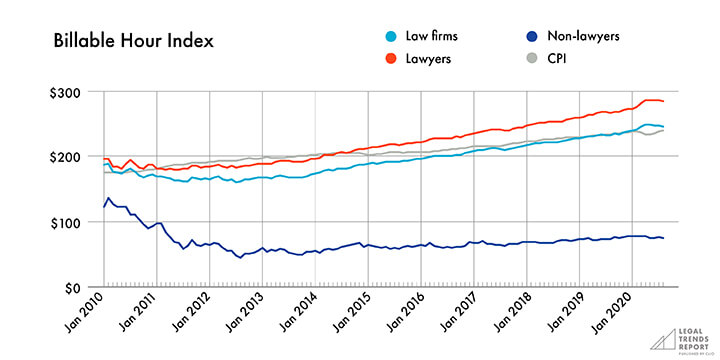
Key performance indicators
Key performance indicators (KPIs) provide unique business insights into firm performance by helping understand how much of a lawyer’s time contributes to firm revenue. Each metric provides data on key areas of a firm’s business, providing valuable action points to improve revenue on an ongoing basis.
The chart below provides data on average KPIs for 2019. As this is 2019 data, it does not look at the impact of COVID-19 on utilization, realization, and collection rates. This will be issued in Clio’s next research report.
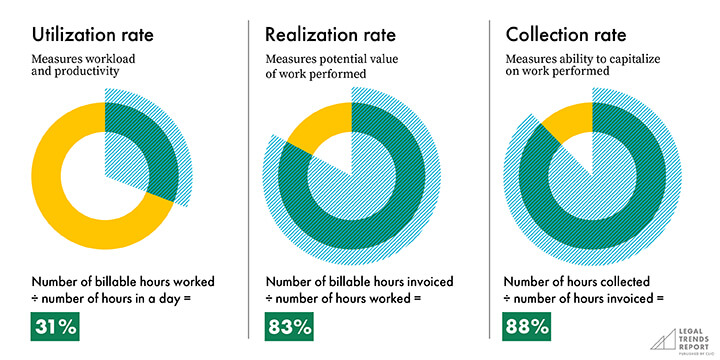
Hourly rates and KPI data for states and practice areas
The Legal Trends Report features aggregated and anonymized data from tens of thousands of legal professionals across the United States. Download the pdf version to get access to the full report, including appendices that include hourly rates and business metrics based on state, metropolitan area, and practice area.
2020 Legal Trends Report
Appendix B
Detailed methodology
- Introduction. Building a vision of a better normal
- Crisis. How times of crisis affect the business of legal practice
- Gains. The aggregation of marginal gains
- Clients. Firm success centers on clients
- Vision. A new vision for cloud-based, client-centered legal practice
- Markets. Addressing underserved legal markets
- Future. The future of law firms will be cloud-based by design
- Appendix A. Hourly rates and KPIs
- Appendix B. Detailed methodology
App data collection
The Legal Trends Report uses aggregated and anonymized data collected from the Clio platform. By synthesizing actual usage data, we’re able to identify trends that would be otherwise invisible to most firms.
The Legal Trends Report has been prepared using data aggregated and anonymized from tens of thousands of legal professionals. These customers were included in our data set using the following criteria:
- They were paid subscribers to Clio. Customers who were evaluating the product via a free trial or were using Clio as part of our Academic Access Program were not included.
- They were located in the contiguous United States. This includes the District of Columbia but excludes Hawaii and Alaska. No customers in other countries were included.
- Any data from customers who opted out of aggregate reporting were excluded.
- Outlier detection measures were implemented to systematically remove statistical anomalies.
Data usage and privacy
The security and privacy of customer data is our top priority at Clio. In preparing the Legal Trends Report, Clio’s data operations team observed the highest standard of data collection and reporting.
Data collection
- All data insights were obtained in strict accordance with Clio’s Terms of Service (section 2.12).
- All extracted data was aggregated and anonymized.
- No personally identifiable information was used.
- No data belonging to any law firm’s clients was used.
Reporting
Aggregate data has been generalized where necessary to avoid instances where individual firm data could be identified. For example, to avoid reporting data on a small town with only one law firm, which would implicate all of this town’s data to this firm, we only report at country, state, and metropolitan levels.
Additionally, raw data sets will never be shared externally. Clio is effectively a tally counter for user interactions—much like stadiums use turnstiles to count visitors without collecting any personally identifiable information from their customers. Similarly, as users interact with the Clio platform they trigger usage signals we can count and aggregate into data sets. We can identify trends without collecting information that reveals anything specific about individual customers.
Survey design
The 2020 Legal Trends Report includes survey data collected between April 3 and August 22, 2020.
Surveys of US legal professionals
- April 3 to 9: 485 respondents
- April 20 to 24: 654 respondents
- May 4 to 14: 609 respondents
- May 18 to 29: 783 respondents
- June 15 to 22: 566 respondents
- July 13 to 22: 635 respondents
- August 6 to 22: 1,044 respondents
Surveys of US consumers (general population)
- April 14: 1,042 respondents
- May 4 and 5: 1,019 respondents
- May 18 and 19: 1,055 respondents
- June 16 to 18: 1,004 respondents
- July 13 to 14: 1,003 respondents
- August 4 to 7: 1,002 respondents
Longitudinal study
Clio’s longitudinal study followed 16 lawyers as they navigated the impact of COVID-19 on their business. The study included interviews in April and May, as well as weekly check-in surveys throughout the study.